Just in case you’ve ever wanted evidence that people do more online searches for porn on weekends (especially Friday nights!):
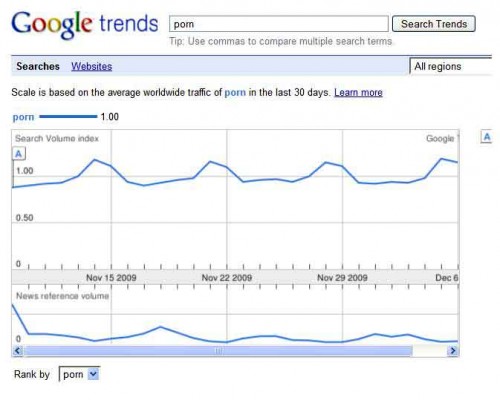
Thanks to Larry.
UPDATE: Reader Dangger sent us a comparison of searches for porn and news:
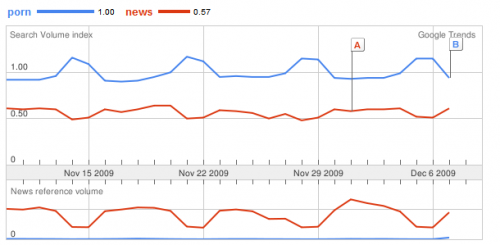
(Via.)
Just in case you’ve ever wanted evidence that people do more online searches for porn on weekends (especially Friday nights!):

Thanks to Larry.
UPDATE: Reader Dangger sent us a comparison of searches for porn and news:

(Via.)
When thinking about how media coverage affects public perceptions, many people think of it in terms of an “injection model”–that is, media outlets “inject” ideas into a passive public, directly affecting what they think (or, anyway, what everyone else thinks, since most people are convinced that they personally aren’t affected). Many researchers have argued this model depicts media audiences as having little agency when it comes to interpreting things they read or hear. People do ultimately decide what they think of issues, though the media play a large role in defining what issues are worth thinking about.
I have spent the last several days being mystified and annoyed by the number of news stories I’ve heard about Tiger Woods and his wreck and apparent affairs. I do not understand why this is national (and even international) news, and why news outlets from Fox to NPR found it worthwhile to have on commentators to talk about the fact that an athlete cheated on his wife.
Upon hearing my grumbling, my friend Larry (of The Daily Mirror) sent in this Google trends graph showing searches for “Tiger Woods” and “Afghanistan” during the last month:
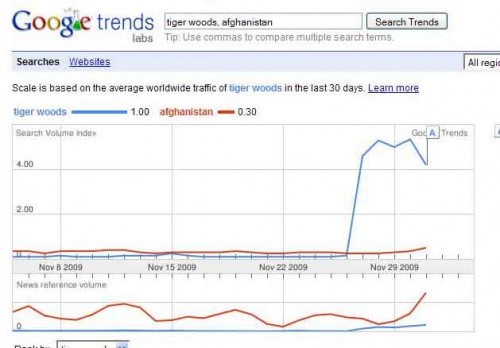
The top graph shows searches for those terms; the bottom graph shows the frequency of them in news stories distributed by Google News. What was interesting to me is that news coverage has actually been higher for Afghanistan, with the gap growing during the days following the Tiger Woods story, but searches have followed the opposite pattern, with the enormous spike in searches for Tiger Woods in the last few days. It’s possible that TV media outlets have covered the Tiger Woods issue more than print media, so that could show a different trend.
But from what we see here, it appears that public interest isn’t being driven solely by media coverage, and any increases in news stories about Tiger Woods may be a response to an appetite for more information. That doesn’t mean media coverage doesn’t play a large part in framing public discourse–after all, we wouldn’t even know about the Tiger Woods story if it didn’t get some initial media coverage–but media outlets don’t decide what to cover in a complete vacuum, with the ability to get the public interested in any story they report on.
UPDATE: Larry sent in this image that contrasts searches for those terms with searches for “porn”:
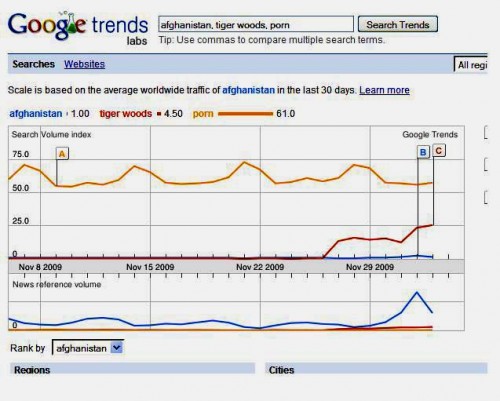
Sigh.
Also see our posts on CNN questioning whether Jon and Kate’s divorce was getting too much coverage, which missing children get media coverage, the media shape reality, and coverage of Obama and Clinton.
Tenured Radical, tired of Facebook ads targeting her with weight loss programs and anti-wrinkle cream, decided to remove her sex from her profile. Lo and behold, Facebook saw her bet and raised her. Now, she reports, each time she clicks on her profile page, Facebook asks her to identify herself as male or female.
I tried it. Here is the pop up:
Tenured Radical’s report is confirmed! Facebook is programmed to nag you. It is so “confusing” when you refuse to be stereotyped according to your sex. Facebook needs to know because how else would it know if you wanted to buy wrinkle cream!!! Aaaaahhhhhh!!!
Tenured Radical writes:
What a hoot. And I have to hand it to them, the tone is perfect: friendly, non-antagonistic, encouraging. I imagine it’s how people might talk to me if I were on a four-day crying jag, or had had a terrible nervous breakdown, or were crashing after a methamphetamine binge. I imagine myself wrapped in lovely warm towels, on soothing drugs and in a pink room with soft music playing in the background. Nurse Ratched is smiling encouragingly with a big, whacking hypodermic in one hand, trying to encourage me in the least threatening possible way to remember what my gender is or to commit to a gender at least, even if it’s not one we can agree on. “Because you see, dear,” Nursie is saying in my imagination; “People may be confused…other people are, well, upset about this, and if you could just answer the question it would be so much better for them.”
Visit our other post on Facebook’s use of a (white) masculine avatar for all subscribers without photos and our post on avatars, gender, and neutrality more generally.
—————————
Lisa Wade is a professor of sociology at Occidental College. You can follow her on Twitter and Facebook.
On Mary K.’s birthday she received the following birthday-related promotion from Best Buy. Notice that the promotion is personalized: it says “Happy Birthday, Mary” in the upper right corner. Nonetheless, the promotion features a tie as an example of a bad gift and a camera as an example of something that Mary might really want.

Given how carefully ads are now targeted to internet users (based both on the demographics it can gather about you [e.g., when you’re on Facebook] and the content of the text you’re reading [e.g., alongside email exchanges]), it’s kind of fascinating that Best Buy is apparently NOT paying attention to Mary’s sex. This, of course, might be heartily welcomed by many of you.
But, if Best Buy is going to put together a non-sex-specific promotion, it sure seems like it would be a good idea to make it non-sex-specific (featuring, as a bad gift, something non-gendered like an electric toothbrush or something). For whatever reason, Best Buy went with “we’re going to assume that all our customers are dudes.”
For more instances of male as the default human, see these posts: one, two, three, and four.
—————————
Lisa Wade is a professor of sociology at Occidental College. You can follow her on Twitter and Facebook.
The answer to that question matters because, even if bloggers don’t have the ability to control what we think, they do, to a certain extent, shape what we think about. And bloggers can sometimes make enough noise to be heard.
Kay Steiger drew my attention to the findings of a study of the blogosphere by Technorati. Below are a selection of their findings, click over for more on who blogs and answers to other interesting questions:
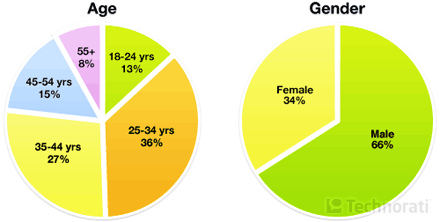


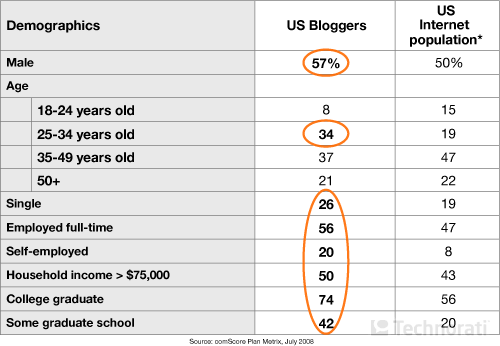
—————————
Lisa Wade is a professor of sociology at Occidental College. You can follow her on Twitter and Facebook.
We recently critiqued Facebook’s “neutral” avatar for appearing both white and male. Both Abby J. and Noah Brier pointed us to the fact that Rob Walker at Murketing has been collecting default avatars. His collection is really interesting. First, it demonstrates that the avatars don’t need to be gendered at all.
Flikr:
![]()
Hotmail:
![]()
Google:

Vimeo:

My space:

Friendfeed:

Yahoo:

Youtube:

Second, it demonstrates that the avatars don’t have to human at all:
Twitter:

Posterous:

Third, his collection also suggests that, when the avatar is human and discernibly gendered, it usually appears to be male. There’s the Facebook avatar, as well as…
EBay:

Car Domain:
![]()
Topix:

Yammer:

The avatar tends to be male, unless the company produces a default male and a default female.
Blip FM:

Goodreads:


This collection reveals that the appearance of a company’s default avatar is by no means inevitable or accidental. Companies must make choices and they are, indeed, making choices about what kind of person is the default person.
Check out his whole collection. It is growing.
Jamie R. sent in a link to a video that presents a lot of attention-grabbing statistics (which may or may not be accurate). At first it appears that the avatar could be unisex, but then at about 1:18, we see the “female” avatar:
Did You Know? from Amybeth on Vimeo.
At no other place in the video do we see the female avatar except when the “neutral” one is presented as married…indicating, from the context of the video, that it is not unisex or neutral, but male.
MORE! You may have noticed that our revamping of the site involved putting our names up. Lo and behold, these male avatars popped up next to our names.
So we went into the admin page to see if we had some other option, like maybe something non-human or a female avatar if necessary. These were our options:
First, blank is really the avatar you see in the first screenshot, it’s neutral which, in reality, is male. So there is no way to opt out of having an avatar (our tech guy, Jon, is still working on it).
Second, there is no female avatar option.
Third, though there is no female avatar, there is a Monster and a Wavatar option, whatever the hell that is. So WordPress is allowing you to represent yourself as a Wavatar, but you’re not allowed to be a chick.
Amazing.
NEW (Apr. ’10)! Keri sent a screenshot of her WordPress menu which, she noted, represents the users with two different skin colors. It’s a nice counterpoint to much of what we see above:
For more on how certain kinds of people get imagined as just people, while others get imagined as certain kinds of people, visit our posts on the Body Worlds exhibit, “flesh” colored products, Pixar films, gender and clothes, and Plan and Playmobile toys.
The Simon Wiesenthal Center just released “iReport: Online Terror + Hate: The First Decade” (pdf) analyzing cyberhate and extremist websites from the last decade. In addition to analysis and pictures of the websites analyzed (I posted some below), the report contains discussions of “cyberhate” and online terrorism, and includes an action plan. See also the NYTimes coverage of the report.
While I would argue that the Internet is no different in terms of composition than the peoples and organizations that make up the Internet (i.e. the Internet reflects and re-creates the racial, ethnic, gender and class divisions found elsewhere), what I think is particularly interesting about this report is how newer Internet technologies (Web 2.0 technologies like social networking sites, collective gaming, blogs, folksonomies) are shaping how these kinds of web content are created and distributed. Just as Web 2.0 technology tailors the information you see about your friends on social networking sites like Facebook, Web 2.0 technology is also making it possible for extremist groups to bring tailored content to targeted groups of interested individuals.
This report has a lot of content that would be perfect for class discussions on the Internet, online activism, how Web 2.0 technology shapes this kind of content, the visibility/invisibility of race, class, gender and other inequalities online, as well as issues of web freedom and monitoring online content. How could this content be regulated and/or censored? Should it be?
Some highlights from the report (p. 3):
• The Internet’s unprecedented global reach and scope combined with the difficulty in monitoring and tracing communications make the Internet a prime tool for extremists and terrorists.
• The Simon Wiesenthal Center has been monitoring these developments for nearly two decades through our Digital Terrorism and Hate Project. Our findings reveal that as the Internet has grown, the escalation of extremist sites has kept pace in number and in technological sophistication.
• In April 1995, the first extremist website went online: Today, the Wiesenthal Center’s Digital Terror and Hate 2.0 identifies some 8,000 problematic hate and terrorist websites and other internet postings. This represents a 30% increase over last year.
• Every aspect of the Internet is being used by extremists of every ilk to repackage old hatred, demean the ‘Enemy’, to raise funds, and since 9/11, recruit and train Jihadist terrorists. Of special concern is the use of the Internet used by the Iranian regime to justify terrorism and spread its influence throughout South America.
• Internet-based hate has inspired some of the most violent hate crimes in America. In this election year, the Internet continues to be used to demean and threaten African Americans, Jews, immigrants, gays and virtually every religious denomination.
• Extremists are leveraging 2.0 technologies to dynamically target young people through digital games, Second Life scenarios, blogs, and even Youtube and Facebook style videos depicting racist violence and terrorism.
And some images of sites included in the report (they are described within the report):